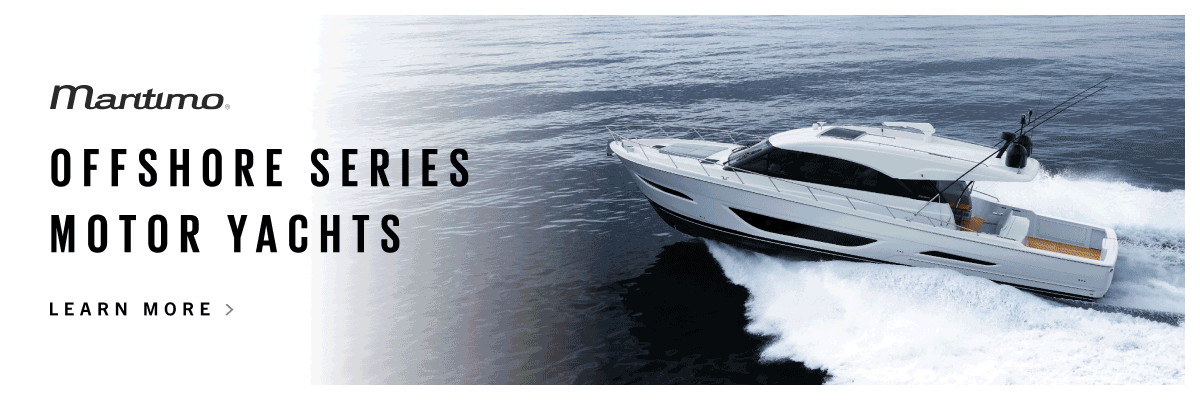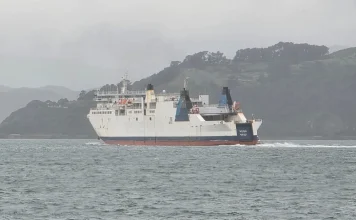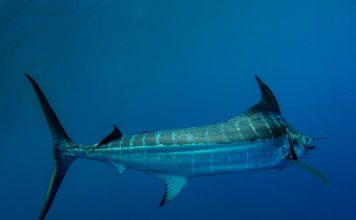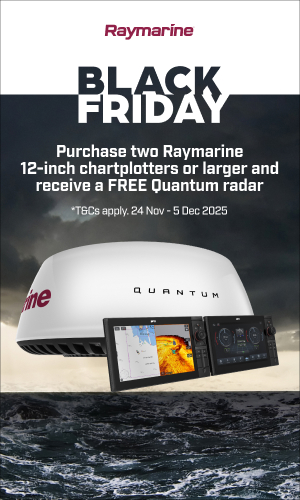One of the perks of being a boat reviewer is that many owners use their boats in the more beautiful parts of the country. So, when I heard that the latest Caribbean 27 Flybridge Sports Fisher was ready for review in Whitianga, there was no hesitation in accepting the challenge.
A fine late winter’s day dawned with very little wind, and photographer Roger Mills and I took a leisurely drive over the Coromandel range and on to Mercury Bay. It is a couple of years since I last reviewed a Caribbean, supported by Tauranga-based Scott White from the sole New Zealand agents, Tauranga Boats Sales Ltd. Since the late 1980s these boats, which originated in the USA, have been built in Melbourne, and it is one of the longest standing brands of luxury sports fishers and cruisers. Generally, Caribbeans are imported to New Zealand as a complete boat, with any custom work that the owner requests. What made this one slightly different was that it was brought over without a drive train.

The new owners had been very happy with their previous boat, a Caribbean 24, but every boat owner eventually wants something just a bit larger. Their wish list included a wider cockpit, a flybridge and something capable of extended offshore game fishing trips in comfort. At the same time, they wanted a boat that could still be stored on a trailer to eliminate the need for a marina berth and reduce the maintenance costs. The Caribbean 27 was perfect for them, with its 3.21m beam, large flybridge and awesome ride.
Scott White says this was the first of the new model 27 Flybridge Sports Fisher they have brought into New Zealand. However factory standard power for this model is a twin Mercruiser petrol sterndrive configuration, which is not a popular option for Kiwis. They therefore brought in a finished standard boat supplied a custom Easytow galvanised trailer, but with no engine, and fitted the driveline components here. This ensures that all the mechanical components were installed by a local supplier who could then take real ownership of the project and ensure everything was perfect right from the start.

John Booker of Pacific Coast Marine, based in Whitianga, was given the brief: Turn the Caribbean 27 into a “Kiwi fishing boat”. He supplied and installed a single Volvo Penta D6-380 diesel engine with an integrated DPI Aquamatic DuoProp sterndrive. A sterndrive is an ideal solution for a boat that is being hauled out after every use, since the drive can be tilted out the way before the boat is hauled and maintenance is easy on a trailer. The Volvo solution adds electronic vessel control and electronic shift and throttle to a solid and robust engine design. In addition, the totally integrated Volvo package is also very compact which made for a clean install.

Modern boats really are a pleasure to drive thanks to those electronics, although some old salts might decry the lack of “seat-of-your-pants” driving. For example, the sternleg automatically trims itself slightly down on acceleration to get the boat up on the plane, then adjusts itself back out once the hull is moving smoothly. This gives astonishing acceleration, with the boat up and planing within five seconds of slamming the throttle down. It takes a mere 10 seconds to get to 26 knots, with full speed coming a few seconds later.
Steering is extremely precise thanks to the digital electric steering, and the ‘stiffness’ of the steering changes with speed – it is superlight at low speed but stiffens up as the boat speed increases. Zipwake trim tabs are generally just left to do their thing – they automatically compensate for the sea conditions or any passenger movements around the boat. The Volvo digital gauges also enable you to see every engine parameter you might want, plus the engine data integrates fully with the Simrad displays.

This boat also includes some features that are crucial for game fishing, such as an integrated autopilot. Long days trolling up and down are effortless thanks to this. Another great feature from Volvo is the low-speed mode. Most engines have a minimum speed of several knots, which is what happens when the engine is just idling in gear. Lower speeds are only possible by going in and out of gear manually, with resultant wear and tear on transmission components. However, the new Volvo sternleg has the DPI electric-over-hydraulic clutch, which allows consistent half-knot speed increments, starting from just half a knot. Of course, the cockpit of the boat has been suitably set up for game fishing, with long carbon-fibre game poles and American-made rotating rod holders set into the gunwales. The boat also reverses well at up to seven knots, so chasing down a fish for tag-and-release is easy.

The engine compartment required a few modifications to accommodate engine dimensions that were different from the factory default. The Volvo was fitted with a short tail housing to reduce its length. Changes to the engine box covering were made, with a 100mm upstand built around the engine box. This box also has an integrated lip drain to make sure no water can get into the engine compartment no matter how much of it splashes around the cockpit. The engine installation allows plenty of space to get all around the motor, while all maintenance items are accessible from the top.

The cabin is spacious and comfortable, and although the sportfisher configuration has an open backed cabin, this can be fully enclosed with the factory supplied canvas bulkhead with zip door and clear windows. The flybridge is also completely open with just a bimini top but factory-supplied all -round clears are an option. The front windscreens are Armourglass, for peace of mind when things turn rough.

Both the main helm and flybridge have very similar electronics configurations, each with a large Simrad multifunction display taking care of chart-plotter, fish finder and autopilot management duties. Of course, for game fishing those Simrad MFDs have been upspec’d with a 3kW transducer, which also provides all the latest down and side imaging options. The Volvo engine has its own digital gauges, but of course the engine parameters are also available on the Simrad.

The electric steering wheel can be tilted up and down, something that very few hydraulic systems offer, and the digital shift and throttle controls are super light to use. Controls for the Zipwake trim system, as well and the SidePower bow thruster, complete the helm layout. Simrad electronics, Zipwake and Sidepower components were all supplied by Advanced Trident Ltd.

Accommodation comprises a huge berth in the forward cabin with infills to make a triple berth, while the dinette table on the port side of the main saloon converts to another berth. There’s a toilet hidden under the centre squab in the main cabin. On the starboard side of the saloon is a galley with sink, under-seat fridge and provision for a small gas or diesel cooker.

After playing around in Whitianga marina with the low-speed mode, we soon headed out past the ferry landing and into beautiful Mercury Bay. Conditions were absolutely perfect and, apart from a chill in the air, you wouldn’t have guessed it was still winter. We soon headed around towards Cathedral Cove and Hahei where we found some larger oceanic swells and so were able to put the boat through her paces.
Although the basic design of the Caribbean has been around for over 60 years, Caribbean has completely refreshed the interior layout to suit modern requirements. At the same time, the company wisely did not mess around with the performance and handling, which remains superb. And we can attest to this – despite there being five large guys on board, moving about constantly, we could hardly feel any movement, whether at rest or while underway. Powering through the swell at speed, and taking the waves on from every angle, caused no drama, helped undoubtedly by those amazing Zipwakes.

We pushed the throttles down hard and could feel the way the electronics helped us get the hull up ‘out the hole’ and planing quickly and efficiently. That big diesel gets her moving along at a pretty decent pace, and we were soon comfortably over 30 knots. Steering at any speed was simple and comfortable, and we tried a few fast, banking turns. No worries. Siince she was a serious game-fishing boat, we also tried coming to a complete stop and then backing up with gusto – she handled and steered well, even at seven knots in reverse.
Fuel consumption for a vessel this size is pretty good, as you might expect from a modern common-rail diesel engine. Optimum cruising speed is 20-22 knots with the engine running at between 2400 and 2600rpm. At this engine speed the fuel burn is an impressive 1.7 litres per nautical mile. Even at full roar, with the engine redlining at 3600rpm, the fuel consumption is just 2.3 litres per nautical mile. And at trolling speeds of six to seven knots with the engines ticking over between 1000 to 1200rpm, the fuel consumption drops right down to 0.7 to 0.9 litres per nautical mile. This gives the Caribbean 27 with its 550-litre fuel tank a huge range – good for several days’ worth of game fishing.

The Caribbean 27 Flybridge Sport Fisher is a seriously impressive boat, and the new owners are rightfully stoked with her. She is perfectly set up for serious fishing expeditions, without too many extraneous frills, but with everything that is required. The Caribbean 27 FSF has the range and capability to handle extended offshore trips – her new owners are looking forward to summer so they can get out there.














